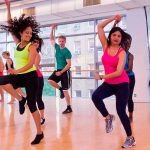A six pack is considered the supreme discipline in muscle training.
After all, a few sit-ups a day is not enough. For the abdominal muscles to become visible under the Exercise is important for a six-pack in two ways. Everyday exercise and, above all, endurance training burn a lot of calories, which make it easier to break down fat and lower the percentage of body fat.
An active everyday life can be implemented by everyone and keeps the metabolism going. Whether it’s a walk during your lunch break, shopping by bike or washing your car by hand – every movement counts.
Regular endurance units also heat up the metabolism and let the fat burning ovens run at full speed.
Strength or abdominal muscle training on the other hand is used to build muscle mass. Advantage: the more muscle mass, the higher the energy requirement. The body permanently consumes more calories even when resting, which in turn plays into the cards for the breakdown of stubborn depot fats (e.g. on the lower part of the stomach) .
Anyone who (still) carries a more or less thick layer of fat in front of them should integrate the amount of exercise as well as the changed diet into everyday life in slow steps. It takes some time for the body to internalize the new processes as a normal state. Therefore, several months should be planned for losing weight.
If you start right away with a brutal six-pack training and a strict diet, you won’t last long. It is much more important to awaken needs . After about 3 to 6 months of healthy eating and regular exercise, you can clearly feel how good exercise is. Once this positive feeling has been internalized, you will hardly want to live without it.
Trained people whose body fat percentage is already at a low level can do the abdominal muscle training more intensively. Then the first successes won’t be long in coming!

Top 11 exercises for a steely sixpack
The possibilities offered by abdominal muscle training are extremely diverse and provide a lot of variety – luckily.
Because who wants to torment themselves with hundreds of crunches every day?
It can be done much better. “Personally, I rely on exercises that challenge several muscle groups at once. Classic crunches and sit-ups are not always bad, but they have the disadvantage that only the superficial abdominal muscles are addressed.
On the other hand, those who devote themselves to the deep-lying muscles and strengthen them will pull the core of the body together like a corset. Result: The stomach appears flatter and more defined . Abdominal exercises, where the core of the body must be kept stable, are particularly suitable for this.
The following 10 basic exercises show a small selection from the wide six-pack exercise portfolio, which, however, will provide steel-hard abdominal muscles with regular use – guaranteed!
1. Folding knife
What? Optimizes the upper and lower abs
How? Lay on your back on an exercise mat. Stretch your arms out next to your head as if trying to lengthen your body.
Extend your legs and lift them up. At the same time, release your shoulders and head from the floor and touch your shins with your fingertips. Don’t forget: always keep your legs straight.
Then move your legs and arms back at the same time. Stop just before the floor and start the exercise again.
Variation: folding knife with knee pulls
To do this, lie on your back and stretch your arms horizontally over the floor (not on the floor!) So that your fingertips point towards your feet.
Straighten your upper body and keep your back straight at all times. Now pull your knees towards your chest, hold them briefly and then return to the extension.
2. Chrunches on the Pezziball
What? Strengthens the straight abdominal muscles
How? Place your lower back and hips on a Pezzi ball (exercise ball). The body should rest on the ball only from the thoracic spine to the middle of the buttocks.
The legs are at a 90 ° angle. Put your feet flat on the floor and find a stable position. The pelvis should be below chest level.
Bring your hands to your temples. Tense your upper body and pelvis, pull in your belly button and slowly straighten your upper body.
Then return slowly and in a controlled manner to the starting position.
3. Cable crunches
What? Challenge the abdominal muscles
How? Kneel in front of the pulley and grab the triceps rope (attached to the upper carabiner). Hold the rope behind your neck with your arms bent, your hands next to your head. Keep your back straight.
Tense your stomach and lower your upper body. Then straighten up again. Important: The strength for the movement must come from the stomach and must not be supported by the arms. So don’t pull your arms down!
4. Side crunches
what? Stabilize the trunk
How? Lie on your back and cross your hands behind your head. Bend your legs together and place them on one side.
Now slowly lift your shoulders and head. Keep your knees together and keep your lower leg on the floor. Hold the position briefly, then slowly return to the starting position. Change sides for the next run.
5. Forearm support with torso rotation
What? Steel your back and firm your stomach
How? Go into the side support. To do this, push your hips up and support your body on your right forearm. The body forms a straight line, the legs are straight.
Now pull your left arm straight towards the ceiling and then slowly bring it under your body. Turn the trunk so that it is almost parallel to the ground. Then return to the side prop position.
6. Forearm support with exercise ball
What? Strengthens your shoulders, tightens your stomach
How? Support your forearms on the exercise ball. Make your back straight and pull in your navel. Extend your legs and stand on your toes.
Hold this position for 30 seconds while remaining as stable as possible. Important: The head forms the extension of the spine all the time and should therefore always be kept straight. So don’t look at the wall clock all the time, but count in your head or occasionally take a look at the heart rate monitor.
7. Leg raises on the dip stand
What? Uses straight and oblique abdominal muscles
How? Stand on the foot platforms, support your forearms on the dip stand and grip the levers with your hands. Press your back firmly against the cushion and pull your shoulders back.
Take your feet off the platforms so your legs are in the air. In the starting position, raise your legs slightly so that the hips are slightly tilted.
Now lift your legs to the horizontal by flexing your hips. The thighs and torso are at a 90 ° angle. Important: Avoid swing during the exercise, the strength must come from the abdominal muscles. Then lower your legs again slowly and in a controlled manner to avoid a hollow back.

The level of difficulty can be increased by lifting the legs straight instead of bent.
Variation: Leg raises on the chin-up bar
This exercise requires more strength, as the entire body weight hangs on the pull-up bar and the upper body is no longer stabilized as with the dip stand.
For exercise, grab the pull-up bar about shoulder width apart. The legs hang freely in a slightly bent position. Now pull your legs (depending on the degree of difficulty) bent up to your chest or almost straight forward. Do without swing and do not swing your upper body. Then return to the starting position.
As a further variant, the legs can first be turned to the right or left when lowering them slightly.
8. Lower legs
what? Improves core and abdominal muscles
How? Lie on your back on a mat. Place both hands under your lower back to support the lumbar spine. Extend your legs and keep them closed.
Now slowly lift your legs and actively tense your stomach and back muscles. Press the lower back into the mat so that there is no hollow back.
Now bring your legs into a vertical position. The soles of the feet point towards the ceiling. Pull your toes towards your body. Then slowly lower your legs down again. Hold just before the heels touch the ground and repeat the exercise.
9. Lying cycling with turns
What? Ideal for the lateral abdominal muscles
How? Lay on your back on the floor. Hold hands to temples as if to do a crunch. Bend and lift your legs until your lower legs are level with the floor.
Bring your left elbow close to your right knee. At the same time straighten your left leg and turn your torso with it.
Hold position briefly, then alternate movement with each leg and elbow.
10. Lunge with torso rotation
what? Defines the thighs, buttocks and lateral abdominal muscles
How? Grab a medicine ball or Velcro bell with both hands and hold it in front of your chest. Take a step back to your knees with the left (lunge step) until your left thigh is vertical. The knee almost touches the floor. The front right thigh is in a horizontal position and the knee perpendicular to the foot.
In the lunge position, turn your upper body to the right. Then turn forwards again, take the next lunge step (with the other leg) and turn in the other direction. Do this alternately.
It is important that the back always remains straight and the head, as an extension of the spine, always goes with the direction of the ball.
11. Squats with shoulder press
what? Strengthens shoulders and buttocks and defines a slim waist
How? Stand shoulder width apart and upright. Hold a medicine ball or kettlebell at step height. The arms are close to the body. Bend your knees with your back straight until your thighs are level.
Push the body up from the squat. Bend your arms in as flowing a movement as possible until the medicine ball /
Velcro bell is just above chest height.
Squat from this position again. Push your body up again and stretch your arms with the weight above your head.
Variation: The exercise can also be performed with a barbell or two dumbbells. In the starting position, the barbell is positioned behind the neck on the shoulders and after the squat is pushed up in a flowing movement (push press).
The dumbbells are brought to shoulder height and, after the squat, pushed over the head as they come up.
and start over if more repetitions are planned.
7 six-pack booster for professionals
Abdominal muscles are just normal muscle tissue. Therefore, the stomach should be trained similarly to all other muscle groups. That means: a normal number of repetitions and sets ( 3-4 sets of 8 to 12 repetitions ), high intensity and depending on the load 30 to 90 seconds break between sets.
Those who are already well trained can try the intensive techniques for tough abdominal muscles and shorten the way to a six-pack.
Sixpack-Booster 1: Super sets
Simply complete two sets in a row and only then take a 30-second break. The sets can exercise the same or different muscle groups . In the first case, the (abdominal) muscles are stressed somewhat more differently due to the different movement sequences.
For exercises that target different muscle groups, two muscle groups should be selected, each opposing the other (e.g. straight abdominal muscles and lower back extension muscles).
Sixpack booster 2: explosive movements
Abdominal exercises can not only be deliberately slow or controlled, but also explosive, i.e. as soon as possible . Instead of the usual number of repetitions per set you can e.g. Go full throttle for 60 seconds and do as many repetitions as you can.
The abdominal muscles are activated to the maximum, which means that maximum strength gains can be achieved during training. This “speed-up training” should only be used for exercises with your own body weight, such as Crunches.
Another advantage: The fast training strongly stimulates the metabolism. Both during and after training, more calories are consumed. The body is put into the “fat burning mode” , which additionally fuels the breakdown of body fat.
Sixpack-Booster 3: Use the lever
The intensity of the abdominal exercises can also be increased completely without equipment. For this one can use so-called levers operate. A lever is the length and angle of a muscle measured from the joint.
The further you move the extremities (arms or legs) away from the stress point, the greater the leverage and thus the intensity or stress. So it is simply about changing the arm and leg position in order to increase the exercise intensity.
So you can e.g. When doing crunches, stretch your arms far behind your head and thereby challenge your abdominal muscles even more. Lengthening the legs when raising and lowering legs also serves as a lever.
If that’s not enough, you can use additional weights or balls for the extension.
Sixpack-Booster 4: Fascia-Stretching-Training (FST)
After normal sets repeat 5 sets of 15 repetitions and keep the weight as high as possible.
The pause time between sets is reduced to 20 seconds . During the break, the target muscle is held in a stretch position. The exercise pumps a lot of blood to the abdominal muscle. The fascia, or the connective tissue that surrounds the muscle, is stretched and the abdominal muscle appears firmer.
Sixpack-Booster 5: High-Intensity-Training (HIT)
The high-intensity training stands for short, but very hard training units . The abdominal muscles are maximally challenged in the shortest possible time.
With 6 to 8 repetitions, each repetition is done slowly and without swing. The load is chosen so that you can barely manage the last repetition (with all your strength).
HIT techniques such as partial repetitions and reduction sets can force further repetitions.
Sixpack-Booster 6: Isometric training
Isometric or static training describes the motionless holding of positions or weights. It can be a useful addition to normal abdominal muscle training and accelerate muscle building. Because the longer time the muscles are under tension, muscle growth is promoted.
Example: Place the back link on a mat so that your hips and shoulders are in contact with the floor. Cross your arms across your chest. Stretch your legs straight up in the air, the soles of your feet pointing towards the ceiling. Now lift your upper body slightly and hold it. Tense muscles as tightly as possible, hold for 30 seconds.

Sixpack-Booster 7: train endurance
So that the painstakingly trained six-pack is not covered by a layer of fat, endurance units such as cycling, running or swimming should also be on the sports program in addition to strength training.
Particularly effective: High Intensity Interval Training (HIIT) . Yes, HIT can also be used in endurance sports.
The training is characterized by alternating stress and recovery phases (intervals). Example: 60 seconds of moderate jogging, 30 seconds of sprinting as fast as you can. The total duration of the training is usually between 15 and 30 minutes – depending on how long you hold out, because interval training makes you sweat a lot.
Advantage: HIIT is by no means as time-consuming as traditional endurance training, but it is just as effective . Since the organism cannot fully recover from time to time due to the intense interval phases, a strong training stimulus is applied to the muscles .
At the same time, the body’s own fat burning ovens are fired up so that the fat layer above the six-pack (and not only there) can effectively disappear … Especially stubborn fat layers , such as those on the lower part of the stomach, can be targeted with HIIT.



